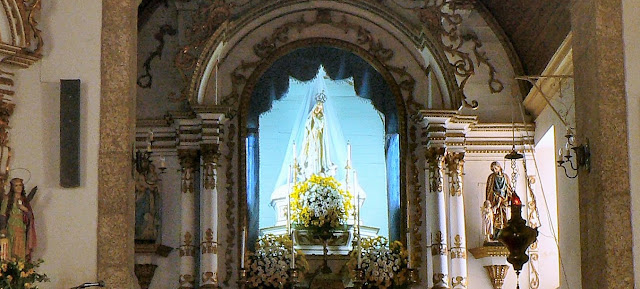LORIGA
40° 19' 37" N; 7° 41' 26" W
Loriga is a Portuguese village and parish in the municipality of Seia, with an area of 36.52 km² and 848 inhabitants (2021). Its population density is 23.2 inhabitants/km².
It has an adjoining village, Fontão. It is part of the Serra da Estrela Natural Park.
It is a civil parish and town in south-central part of the municipality of Seia, in central Portugal. Part of the district of Guarda, it is 20 km away from the city of Seia, 40 km away from Viseu, 80 km away from Guarda and 320 km from Lisbon, nestled in the Serra da Estrela mountain range.
History
Loriga was founded along a column between ravines where today the historic centre exists. The site was ostensibly selected more than 2000 years ago, owing to its defensibility, the abundance of potable water and pasturelands, and lowlands that provided conditions to practice both hunting and gathering/agriculture.
When the Romans arrived in the region, the settlement was concentrated into two areas. The larger, older and principal agglomeration was situated in the area of the main church and Rua de Viriato, fortified with a wall and palisade. The second group, in the Bairro de São Ginês, were some small homes constructed on the rocky promintory, which were later appropriated by the Visigoths in order to construct a chapel. The 1st-century Roman road and two bridges (the second was destroyed in the 16th century after flooding in the Ribeira de Loriga) connected the outpost of Lorica to the rest of their Lusitanian province. The São Ginês' neighbourhood (São Gens), a local ex-libris, is the location of the chapel of Nossa Senhora do Carmo, an ancient Visigothic chapel.
Geography
Known locally as the "Portuguese Switzerland" due to its landscape that includes a principal settlement nestled in the mountains of the Serra da Estrela Natural Park.[3] It is located in the south-central part of the municipality of Seia, along the southeast part of the Serra, between several ravines, but specifically the Ribeira de São Bento and Ribeira da Nave;[3] it is 20 kilometres from Seia, 80 kilometres from Guarda and 300 kilometres from the national capital (Lisbon). A main town is accessible by the national roadway E.N. 231, that connects directly to the region of the Serra da Estrela by way of E.N.338 (which was completed in 2006), or through the E.N.339, a 9.2 kilometre access that transits some of the main elevations (960 metres near Portela do Arão, and 1650 metres around the Lagoa Comprida).
The region is carved by U-shaped glacial valleys, modelled by the movement of ancient glaciers. The main valley, Vale de Loriga was carved by longitudinal abrasion that also created rounded pockets, where the glacial resistance was minor. Starting at an altitude of 1991 metres along the Serra da Estrela the valley descends abruptly until 290 metres above sea level (around Vide), passing villages such as Cabeça, Casal do Rei and Muro. The central town, Loriga, is seven kilometres from Torre (the highest point), but the parish is sculpted by cliffs, alluvial plains and glacial lakes deposited during millennia of glacial erosion, and surrounded by rare ancient forest that surrounded the lateral flanks of these glaciers.
Economy
Textiles are the principal local export; Loriga was a hub the textile and wool industries during the mid-19th century, in addition to being subsistence agriculture responsible for the cultivation of corn. The Loriguense economy is based on metallurgical industries, bread-making, commercial shops, restaurants and agricultural support services.
While that textile industry has since dissipated, the town began to attract a tourist trade due to its proximity to the Serra da Estrela and Vodafone Ski Resort (the only ski center in Portugal), which was constructed totally the parish limits.
RIVER BEACH OF LORIGA
40.327253º N, 7.678467º W
Located in an ancient glacial valley, this beach is undoubtedly one of the ex-libris of Loriga, and enchants all its visitors with its natural beauty.
Here you can dive into the clear and fresh waters of the Nave stream and also enjoy waterfalls and small natural pools.
In the area it is possible to find several characteristic species of aquatic environments such as river trout, blackbird and otter.
💓💓💓💓💓
SEARCH IN ALPHABETICAL ORDER
IN THE DISTRICT OF GUARDA

Aguiar da Beira;
Almeida;
Almendra;
Castelo Bom;
Castelo Melhor;
Castelo Rodrigo;
Celorico da Beira;
Figueira de Castelo Rodrigo;
Fornos de Algodres;
Freixo de Numão;
Golfar + A-do-Cavalo;
Almeida;
Almendra;
Castelo Bom;
Castelo Melhor;
Castelo Rodrigo;
Celorico da Beira;
Figueira de Castelo Rodrigo;
Fornos de Algodres;
Freixo de Numão;
Golfar + A-do-Cavalo;
Moreira de Rei (Trancoso);
Numão;
Pinhel;
Ranhados;
Sabugal;
Seia;
Serra da Estrela Nature Park;
Sortelha;
Trancoso;
Valhelhas;
Vila Nova de Foz Côa;
Vilar Formoso;
Numão;
Pinhel;
Ranhados;
Sabugal;
Seia;
Serra da Estrela Nature Park;
Sortelha;
Trancoso;
Valhelhas;
Vila Nova de Foz Côa;
Vilar Formoso;
💓💓💓💓💓
Return to mainland Portugal &
the Azores and Madeira islands
























